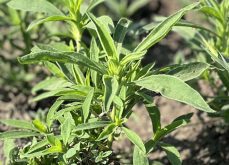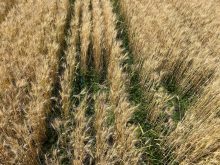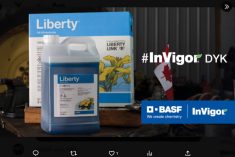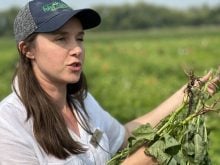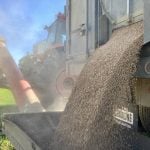Markets don’t care about good intentions; they care about what’s in the grain.
Even small slip-ups with pesticide use can lead to residue problems at delivery, and that’s a risk no one wants to take.
That’s where Keep it Clean comes in. The industry-led initiative is a collaborative effort among Canadian commodity associations, including Cereals Canada, the Canola Council of Canada, Pulse Canada and the Prairie Oat Growers Association. The aim is to give farmers the tools and information they need to ensure their grain meets the stringent requirements of international markets.
Read Also

Claas brings 1000 Series SP forage harvesters to Canada
In mid-August, Claas unveiled its new line of Jaguar forage harvesters at an event in Visalia, California, deep in the heart of that state’s dairy region.
It’s about making sure farmers aren’t limited in where their crops can go, says Jeff English, Pulse Canada’s vice-president for marketing and communications.
Keep it Clean released its 2025 product advisory list last month and held a webinar April 24, where representatives from the commodity associations walked through the changes.
“More than 90 per cent of our canola, more than 80 per cent of our wheat, and more than 85 per cent of our pulses are exported,” says Krista Zuzak, vice-president of communications and value chain relations with Cereals Canada. “This makes it really important for us to be able to meet not only domestic requirements but also our export requirements.”
A lot of the discussion revolves around what’s known as maximum residue limits, or MRLs. These are the highest levels of pesticide residue allowed on food products in a given market, and they vary by country.
Zuzak stresses that producers need to know what they’re selling — and that means knowing what’s been applied to the crop. If a grower misrepresents their grain, even unintentionally, they could be liable. What’s detected in a shipment can be traced back quickly. If residues are found that don’t match a market’s tolerance levels or restrictions, the issue doesn’t stop with the exporter — it comes back to the farm.
Avoiding problems
To avoid costly surprises, Zuzak outlines three key steps every farmer should be taking: follow labels, know maximum residue limits and document everything.
Labels are legally binding documents, not suggestions.
“Pay attention to the rate, the timing and the pre-harvest interval to help keep those MRLs in check.” Spraying too late, applying too much or shortening the pre-harvest interval all increase risk.
Just because a product is registered in Canada doesn’t mean it’s accepted in all markets. Zuzak says growers should ensure pesticides are approved by key export destinations, particularly if the grain is likely headed overseas. It’s up to the grower to understand what they’re applying and where that grain might go.
Some products have MRLs that differ by country. For instance, a crop might meet Canadian standards but fail in a market such as Japan or the EU.
If you’re delivering grain, you need to know its history. Zuzak said it’s important to be honest and accurate about production practices. If a product isn’t permitted and residues show up, there could be contract penalties, rejected loads or other consequences.
She also recommended talking to grain buyers ahead of delivery to check for any product advisories or “do not use” lists. Tolerances can vary between buyers, contracts and destination countries. It’s a lot easier to make the right decision before the crop is in the bin.
“So, ask those questions.”
Key advisories for 2025
The biggest news in this year’s update was that grain treated with lambda-cyhalothrin can once again be used for livestock feed, resolving the feed ban issue from the 2021 review.
“As of February of this year, the feed restrictions, have been lifted for lambda,” Canola Council agronomy specialist Ian Epp says. “So, for oils, pulses and cereal grains, it’s now acceptable.”
While there are no new advisories for cereals in 2025, Zuzak highlights some ongoing market access challenges.
Glyphosate is listed as “amber” for all cereals except malt barley, meaning it should only be used for pre-harvest weed control — never for desiccation.
For food and feed barley, the fungicide fluopyram is listed as amber due to missing MRLs for China and a very low MRL in Japan (0.01 ppm). Another fungicide, tetraconazole, is listed as “red – do not use” because MRLs are missing for both China and Codex. The growth regulator chlormequat is listed as amber, because some markets have restrictions, so check with grain buyers.
Malt barley has stricter rules. Fluopyram and tetraconazole are both listed red. Chlormequat remains amber with buyer confirmation recommended. Glyphosate is red and should not be used on malt barley. Saflufenacil is also red due to concerns about malt quality.
Zuzak said desiccants such as glufosinate and diquat have a higher residue risk because they’re applied late in the season.
“These are not registered for use on cereals and can cause serious market access issues.”
Keep it Clean flagged several key products for pulses in 2025. Jeff English says growers should be careful using them, to avoid market risks.
New for 2025, flonicamid (Carbine) is now amber for green lentils due to uncertainty around EU residue limits. Check with buyers before using it.
Glyphosate is listed as amber for all pulses for pre-harvest weed control. It’s permitted but only when used properly. That means it’s not to be used for desiccation and only when seed moisture is below 30 per cent. In Eastern Canada, most dry bean dealers won’t allow glyphosate.
The desiccant glufosinate-ammonia is also red for all pulses in Western Canada and, except for very limited circumstances, in Eastern Canada as well.
“The basic assumption should be that it (glufosinate-ammonia) is not accepted,” English says. “I would encourage growers to speak directly with their with their buyers, to ensure that they’re not doing anything that would put that crop at risk.”
He also says dry beans are especially sensitive when it comes to market access. Even small residue issues can lead to load rejections.
There are no markets of concern for canola again this year, so growers following label directions should be in the clear.
However, Epp says, growers cannot use malathion to treat bins for insects, as even trace residues from treated bins can jeopardize market access.
He also says timing is critical — especially with glyphosate.
“In applications that are made too early, we see unacceptable residues. They’re testable, and they can cause some agronomic problems too.”
Epp says it’s important to ensure grain moisture is below 30 per cent before applying.





